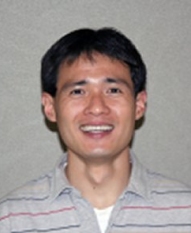Biological Science Faculty Member
Dr. Hong-Guo Yu
- Office: 361 Biology Unit I
- Office: (850) 645-4768
- Area: Cell and Molecular Biology
- Lab: Biology Unit I
- Lab: (850) 645-4769
- Fax: (850) 644-0481
- Mail code: 4370
- E-mail: hyu@fsu.edu

Professor
Ph.D., University of Georgia, 2000
Graduate Faculty Status
Research and Professional Interests:
Our research goal is to understand how chromosomes organize themselves and segregate during cell division. In mitosis the cell replicates itself by equally partitioning duplicated chromosomes. In contrast, during the first division of meiosis, homologous chromosomes pair, recombine, then separate, but sister chromatids remain joined together until the second division of meiosis. Understanding the dynamics of chromosome organization and segregation during meiosis can provide insights into the causes of birth defects and aneuploidy.
We have been studying how two highly conserved protein complexes called cohesin and condensin function in chromosome organization and segregation. Recently, we have expanded our research to an exciting new frontier focused on determining the mechanics of the nuclear envelope involved in regulating chromosome movement, recombination, gene expression, and cellular rejuvenation. We use budding yeast as a genetic model in our studies.
Selected Publications:
1. Fan, J., H. Jin, B.A. Koch, and H.-G. Yu. (2020) Mps2 links Csm4 and Mps3 to form a telomere-associated LINC complex in budding yeast. Life Science Alliance 3(12):e202000824 http://doi.org/10.26508/lsa.202000824.
2. Koch, B.A., E. Staley, H. Jin, and H.-G. Yu. (2020) The ESCRT-III complex is required for nuclear pore complex sequestration and regulates gamete replicative lifespan in budding yeast meiosis. Nucleus 11(1):219-236.
3. Koch, B.A. and H.-G. Yu. (2019). Regulation of inner nuclear membrane associated protein degradation: lessons from budding yeast. Nucleus 10(1):169-180.
4. Koch, B.A.,H. Jin, R.J. Tomko Jr., and H.-G. Yu. (2019) The anaphase-promoting complex regulates the degradation of the inner nuclear membrane protein Mps3. Journal of Cell Biology 218: 839-854. (FSU news)
5. Agarwal, M., H. Jin, M. McClain, J. Fan, B.A. Koch, S.L. Jaspersen, and H.-G. Yu. (2018). The half-bridge component Kar1 promotes centrosome separation and duplication during budding yeast meiosis. Molecular Biology of the Cell doi: 10.1091/mbc.E18-03-0163.
6. Li, P., H. Jin, B.A. Koch, R.L. Abblett, X. Han, J.R. Yates, III, and H.-G. Yu. (2017). Cleavage of the SUN-domain protein Mps3 at its N-terminus regulates centrosome disjunction in budding yeast meiosis. PLoS Genetics 13(6):e1006830. https://doi.org/10.1371/journal.pgen.1006830.
7. Li, P., Y. Shao, H. Jin, and H.-G. Yu. (2015). Ndj1, a telomere-associated protein, regulates centrosome separation in budding yeast meiosis. Journal of Cell Biology 209:247-259.
The following URL leads to a full list of published work at NCBI: https://www.ncbi.nlm.nih.gov/myncbi/hong-guo.yu.1/bibliography/public/
